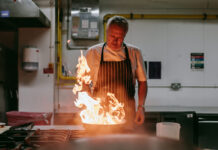Draft document unveils series of measures for different business types

PREVENTING customers from standing at the bar, removing cutlery and condiments from tables, and having a system in place to avoid customer toilets from becoming overcrowded are among the measures outlined in draft protocols for hospitality businesses reopening following the COVID-19 closure.
Industry trade group UK Hospitality has drafted proposed measures for different types of business within the sector intended to underpin operators’ individual risk assessments for their premises which should outline how they are implementing guidance to keep staff and customers safe. The organisation said it will be key to ensure that all elements of the risk assessment can be evidenced in a practical way in line with government COVID-19 Secure guidelines, adding that it expects compliance checks may be carried out by environmental health officers.
UK Hospitality said the advice outlines core areas operators should focus on and specific functions which should be considered as part of individual reopening plans and Covid-19 Secure risk assessments. It has advised operators to make any adjustments to operating procedures and premises based on the advice and any other changes identified; and to talk to staff to gauge their concerns, whether the plan addressed them and, if not, how these can be addressed.
Measures outlined in the draft document include:
General staff safety for all premises types
- Ask all staff to wash their hands immediately before leaving home and to wash their hands immediately upon arrival at work.
- Duty managers/appropriate person should remind everyone to wash their hands again at the start of every shift (in addition to washing hands at arrival). That way any virus particles picked up on the way to work are removed before they can be spread to others either via direct contact (do not shake hands) or by touching hand contact surfaces (door handles, tables, kettle handles, kitchen equipment, etc.)
- Heightened disinfection needs to be undertaken to disinfect all frequently touched areas in staff areas, such as tables, chairs, counters tills, card machines, etc.
Pubs and bars
- Assess the flow of staff and customers in the pub as part of the risk assessment. For bar orders, inform customers to keep the minimum safe distance from bar staff as well as from other customers waiting in a queue to be served, eg. directed by tape marks on the floor, signage.
- Measures to consider include managing the bar to create directional movement of customers ordering drinks at a till point, then moving to a second point to collect their drinks.
- Consider restrictions on customers remaining at the bar after ordering and getting their drink.
- Advise that empty glasses are collected from tables by staff, and customers discouraged from returning empty glasses to the bar.
- Beer gardens/outside areas: although easier to manage if it is a large outdoor area, there is a danger of groups forming. Consider as part of your risk assessment regular patrol of outside areas, smoking/vaping areas, restrictions that may be required for children’s play areas.
- Toilets: as part of your risk assessment, have a plan specifically for customer toilets to ensure compliance with physical distancing rules and ensure all staff are aware.
Restaurants and casual dining
- Individually wrapped condiments and sauces should be offered on request and put with the plated food, not left on tables.
- Cutlery to be brought to the customer with the food and condiments rather than customers helping themselves or leaving them on tables.
- Develop a table plan and arrangement based on the current physical distancing distance guidelines operational at the time.
- Customer contact with commodities (eg. menus, trays, napkins) should be limited to what is necessary or designed in such a way that cleaning/replacement is carried out after each use. Menus left on tables/table talkers discouraged in favour of other forms of display to the customer. Consider the use of single-use/laminated menus brought to the table.
- Use disinfectants and sanitisers that are effective against bacteria as well as cold and flu viruses, as recommended by the current government advice.
- Cleaning regimes for kitchens should reflect the need to reduce risk from coronavirus as well as maintaining all normal expectations relevant to a food business regarding hygiene.
- Control movements of staff to maintain mandated social distancing measures where possible, ie. one person at a time allowed in the chilled or dry stores, changing rooms and toilets.
- Handwashing of glassware, plates and cutlery should be avoided where possible with glassware washed separately from plates and cutlery.
Hotels
- If staff help guests with luggage, they should keep the required distance apart from guests whilst collecting luggage and either take it to the room before the guest arrives there or knock on the door, leave the luggage at the door and step back. After handling luggage, staff should wash their hands or use a hand sanitiser afterwards.
- Room service: consider using trays which can be left off the floor next to the door, or think of other ways to protect the order, eg. a small light table or a folding luggage rack, both of which have been disinfected first. Staff should knock on the door, leave the tray outside the door and step away. The guest can then pick the tray up, and the staff can remove the tray stand or table, etc.
- Lifts: consider minimising lift usage from reception, and advice for safer use of lifts throughout the hotel can be advised in pre-stay communications and in-building signage and staff communications.
- Consider a central key card deposit box placed in lobby for disinfection of room keys.
- Reception: no handshakes; adopt a USP for greeting guests.



















